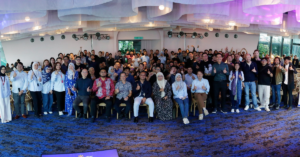FYUZ 2023: Connectivity the key to metaverse success

A new generation of devices and content aiming to take advantage of the metaverse in a range of business and consumer applications will drive network demand to new levels, with customer experiences for such services posing challenging latency and throughput requirements, according to leading Spanish operator Telefónica.
Speaking at the FYUZ 2023 conference, Juan Carlos Garcia, senior vice-president for technology innovation and ecosystem at the global operator, warned that networks would have to evolve to support the new architectures and technologies that will be integrated and activated by the metaverse layer through application programming interfaces (APIs).
Garcia predicted that the evolution would encompass a number of devices and use cases over the next six years, growing from virtual reality (VR) applications such as social media, 360 video, gaming and live broadcasts accessed through VR headsets, to an augmented reality (AR) world in 2027 that would be defined by retail, social and telepresence accessed using tethered AR glasses.
By 2029, he said, extended reality (XR) would be the application of choice in use cases such as mixed social reality, mixed reality events, holographic communications and mixed reality gaming. The access device of choice would likely be standalone AR glasses.
But at present, Garcia said the metaverse was in still in the adoption phase and the ecosystem players were creating the initial enablers and first experiences of the metaverse to understand the type and form of applications that will be seen in the next five years.
“In five to 10 years, there will be a proliferation of different worlds where we will be working in the metaverse and there are a [large number] of things that need to happen to make it possible,” he remarked.
“We need devices that have the proper user interface to access the metaverse. These go from a smartphone adaptation to special headsets and glasses. Today, [we are using] consoles and personal computers. We will have to adapt the user interface to this new experience. We’ll have to develop tools to be able to deliver the metaverse, like 3D engine tools, blockchain for making payments, e-commerce networks. To support visualisation, [we’ll need] a lot of artificial intelligence to manage such complex scenarios,” Garcia added.
Yet before these use cases can be exploited to their fullest potential, and indeed supported in their basic form, networks will also need to evolve. Garcia noted that along its journey, the metaverse would need to make full use of existing and new networking capabilities.
At present, experiences will be supported after placing strong requirements on devices for local processing. There will be limited or no offload for mobile broadband. By contrast, tomorrow’s networks – encompassing access, core and internet – will be based around edge cloud rendering with stronger requirements on networks and the cloud.
Drilling deeper into medium-term requirements, Garcia cautioned that that despite the fact that many countries, in particular Spain, will have fully digital fibre networks, XR traffic will have a significant impact on those networks.
Telefónica calculated that by 2027, to support extended video, the network load would be an average bit rate per user of 50Mbps and bandwidth per user of 150Mbps, resulting in a latency of 20ms (milliseconds). For XR cloud, this would typically be an average bit rate per user of 430Mbps and 160Mbps of bandwidth per user, with latency of 15ms.
By 2029, enhanced video would see average bit rates per user of around 100Mbps with the average user needing 300Mbps in bandwidth for a 20ms latency. Cloud apps would see need 360Mbps per user with average bit rate per user of 90Mbps to deliver latency of 10ms.
Such capabilities are well beyond traditional service requirements with average bit rate per user of 0.1Mbps and 0.15Mbps of bandwidth per user with latency in the ballpark of 30-60ms. The bottom line is that to support future applications, new network capabilities will have to be put in place to attend to the expected evolution in demand.
Looking forward, Garcia said that to support metaverse use cases, metaverse-enabling capabilities such as network slicing, edge and quality of service on demand (QoD) would help drive infrastructure requirements. He said work being carried out by the Telecoms Infra Project (TIP) could ensure that the correct technological framework could be defined and a roadmap built. This would map out when to deploy key metaverse-enabling network capabilities and to support key APIs facilitating integration and activation of key network capabilities from metaverse platforms.
Source link
#FYUZ #Connectivity #key #metaverse #success





